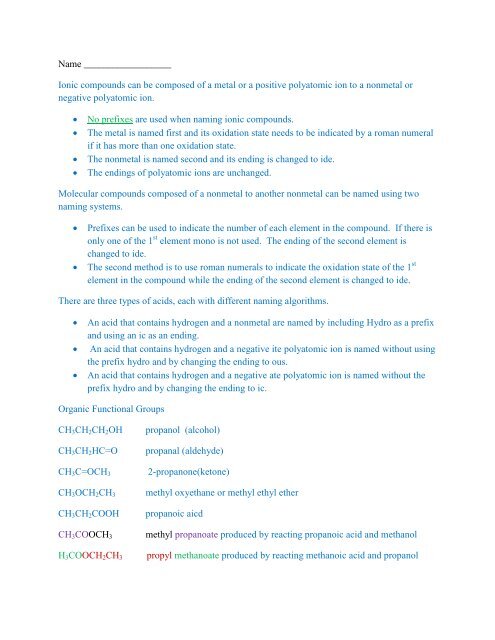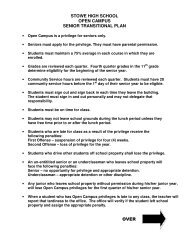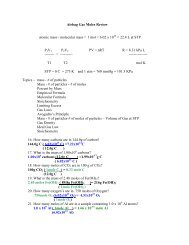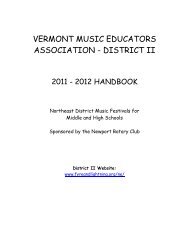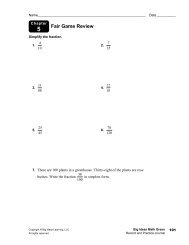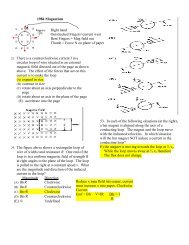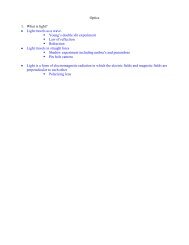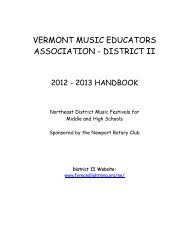2013 nomenclature test answers
2013 nomenclature test answers
2013 nomenclature test answers
Create successful ePaper yourself
Turn your PDF publications into a flip-book with our unique Google optimized e-Paper software.
Name __________________<br />
Ionic compounds can be composed of a metal or a positive polyatomic ion to a nonmetal or<br />
negative polyatomic ion.<br />
<br />
<br />
<br />
<br />
No prefixes are used when naming ionic compounds.<br />
The metal is named first and its oxidation state needs to be indicated by a roman numeral<br />
if it has more than one oxidation state.<br />
The nonmetal is named second and its ending is changed to ide.<br />
The endings of polyatomic ions are unchanged.<br />
Molecular compounds composed of a nonmetal to another nonmetal can be named using two<br />
naming systems.<br />
<br />
<br />
Prefixes can be used to indicate the number of each element in the compound. If there is<br />
only one of the 1 st element mono is not used. The ending of the second element is<br />
changed to ide.<br />
The second method is to use roman numerals to indicate the oxidation state of the 1 st<br />
element in the compound while the ending of the second element is changed to ide.<br />
There are three types of acids, each with different naming algorithms.<br />
<br />
<br />
<br />
An acid that contains hydrogen and a nonmetal are named by including Hydro as a prefix<br />
and using an ic as an ending.<br />
An acid that contains hydrogen and a negative ite polyatomic ion is named without using<br />
the prefix hydro and by changing the ending to ous.<br />
An acid that contains hydrogen and a negative ate polyatomic ion is named without the<br />
prefix hydro and by changing the ending to ic.<br />
Organic Functional Groups<br />
CH 3 CH 2 CH 2 OH<br />
CH 3 CH 2 HC=O<br />
CH 3 C=OCH 3<br />
CH 3 OCH 2 CH 3<br />
CH 3 CH 2 COOH<br />
CH 3 COOCH 3<br />
H 3 COOCH 2 CH 3<br />
propanol (alcohol)<br />
propanal (aldehyde)<br />
2-propanone(ketone)<br />
methyl oxyethane or methyl ethyl ether<br />
propanoic aicd<br />
methyl propanoate produced by reacting propanoic acid and methanol<br />
propyl methanoate produced by reacting methanoic acid and propanol
1. What is the name of KCN<br />
potassium monocarbon mononitride<br />
potassium carbide<br />
potassium cyanide potassium monocyanide potassium (I) cyanide<br />
2. What is the name of HClO 2 (aq)<br />
hydrogen chlorate hydro chloric acid chloric acid<br />
hydrogen chlorite hydro chlorous acid chlorous acid<br />
3. What is the name of CF 4 ?<br />
carbon fluoride carbon (IV) fluoride carbon (I) fluoride<br />
carbon tetrafluoride<br />
monocarbon tetrafluoride<br />
4. What is the name of RbNO 3 ?<br />
rubidium nitride rubidium nitrate rubidium nitrite<br />
trirubidium nitride<br />
trirubidium mononitride<br />
rubidium (III) nitride rubidium (I) nitride rubidium(I) nitrate rubidium (III) nitrite<br />
5. What is the name of P 2 O 10 ?<br />
phosphate diphosphorous decaoxide phosphorous pentaoxide<br />
phosphorous oxide phosphorous (X) oxide phosphorous (V) oxide<br />
6. What is the name of (NH 4 ) 2 S ?<br />
dinitrogen octahydride monosulfide diammonium monosulfide<br />
ammonium sulfide ammonium (II) sulfide ammonium sulfate<br />
ammonium (II) sulfite<br />
7. What is the name of V 2 O 3<br />
divanadium trioxide trivanadium dioxide vanous acid<br />
vanic acid<br />
vanadium oxide<br />
vanadium (II) oxide vanadium (III) oxide
8. What is the name of Na 3 P?<br />
sodium phosphate sodium (III) phosphate<br />
sodium phosphide sodium (I) phosphide<br />
trisodium monophosphorous tetra oxide sodium phosphorous sodium phosphoric acid<br />
9. What is the name of H 2 C 2 O 4 (aq)?<br />
hydrogen oxalate hydro oxalic acid oxalic acid oxalous acid<br />
dihydrogen dicarbon tetraoxide<br />
dihydrogen monooxalate<br />
10. What is the name of Au 2 CO 3 ?<br />
gold carbonate digold carbon tiroxide gold (I) carbonate<br />
gold (III) carbonate gold carbonic gold carbonous<br />
11. What is the formula of phosphoric acid H +1 PO -3 4 Criss Cross<br />
HP H 3 P HP 3 H 3 PO 3 H 3 PO 4<br />
12. What is the formula of ammounium phosphite (NH 4 ) +1 -3<br />
PO 3<br />
NH 4 P NH 4 PO 3 NH 4 PO 4 (NH 4 ) 3 PO 3 (NH 4 ) 2 PO 4 (NH 4 ) 3 PO 4<br />
13. What is the formula of aluminium thiosulfate Al +3 -2<br />
S 2 O 3<br />
Al 2 S 3 Al 3 SO 3 Al 2 (SO 4 ) 3 Al 2 (S 2 O 3 ) 3 Al 3 (SO 4 ) 2<br />
14. What is the formula of barium nitrate Ba +2 (NO 3 ) -1<br />
BaN Ba 3 N 2 Ba 2 N 3 Ba(NO 2 ) 2 Ba(NO 2 ) 3 Ba(NO 3 ) 2<br />
15. What is the formula of chromic acid? H +1 -2<br />
CrO 4<br />
H 2 Cr CrO 4 H 2 Cr 3 HCrO 4 H 4 CrO 4 H 2 CrO 4<br />
16. What is the formula of nickel(II)phosphide Ni +2 P -3<br />
NiP NiPO 3 NiPO 4 Ni 3 P 2 Ni 3 ( PO 3 ) 2 Ni 2 (PO 4 ) 3<br />
17. What is formula of phosphorous trichloride? Prefixes<br />
PCl PCl 3 P 3 Cl PClO 3 PCl 3 O<br />
18. What is the formula of hydrobromic acid? H +1 Br -1<br />
H 2 Br HBr HBrO 3 H 2 BrO 3 HBrO 2
Monosaccharide Disaccharide Polysaccaride<br />
Cis monunsaturated fatty acid 1,2,3 propantriol trans monounsaturated fatty acid<br />
Saturated Fatty Acid<br />
triglyceride
amino acid dipeptide polypeptide<br />
Protein<br />
Water soluble vitamin<br />
Fat Soluble Vitamin<br />
Mineral<br />
Ca 2+ (aq)
24. Which of the structures is coded by DNA? Protein,polypeptide,dipeptide<br />
31. Which of the structures primary function in human nutrition is for energy?<br />
monosaccaride – disaccharide - polysaccharide<br />
32. Which of the structures releases 9 kcal /g?<br />
triglyceride – fatty aicds<br />
33. A lack of which structures would create a deficiency disease?<br />
34. The three dimension shape of which structure and therefore function be altered by adding an<br />
acid and heating the sample in a process that leads it to be denatured?<br />
Protein<br />
35. Which of the structures can react with three fatty acid molecules to form a<br />
triglyceride?<br />
1,2,3 propantriol<br />
36. Which of the structures can react with Benedicts solution turning it from blue solution to a<br />
reddish orange suspension?<br />
monosaccharide<br />
37. Which is important ion soluble mineral that is essential for the maintenance of bone tissue?<br />
metallic positive ions and nonmetallic negative ions<br />
Answer 1 of the following 2<br />
38.What are four functions of<br />
a) Proteins – check pre<strong>test</strong><br />
b) Fats / Lipids check pre<strong>test</strong><br />
39. What force determines the three dimensional structure of proteins?<br />
a) gravitational force b) electrostatic force c) magnetic force d) frictional force<br />
e) tension force f) strong nuclear force<br />
40. Which of the following are caused by regions of positive and negative charges on<br />
molecules?<br />
a) London dispersion forces b) dipole dipole c) hydrogen bonding d) all of these
A. 1-pentamine B. pentanol<br />
C. 1,1,1,2,2,2 hexafluropentane<br />
D. pentanal E. ethyl propyl ether F. ethyl propanoate<br />
G. propyl ethanoate H. 2,2,3-trifluoropentane 3-pentanone<br />
I.<br />
pentanoic acid<br />
3-pentamine<br />
J. K.<br />
I.
53. How many of each is represented by 2 Ni 2 (CO 3 ) 3 ?<br />
a) What is the total number of Ni? 2x2=4<br />
b) What is the total number of C? 2x1x3=6<br />
c) What is the total number of O? 2x3x3=18<br />
d) What is the total number of CO 3 ? 2x3=6<br />
e) What type of compound is it? metal to negative polyatomic ion = ionic<br />
f) What is its name? nickel (III) carbonate<br />
54a) Balance the following reaction and identify what type of reaction it is and why?<br />
___2___ Rb (s) + ___2__ H 2 O (aq) __1___RbOH (aq) + __2__ H 2 (g)<br />
b) type? Why? Single replacement: the rubidium replaces the hydrogen in the dihydrogen<br />
monoxide. A + BZ AZ + B.<br />
55. Balance the following reaction and identify what type of reaction it is and why? 3pts<br />
__1___ C 5 H 12 (g) + ___5__ O 2 (g) -----> ____1__ C (s) + __4__CO + ___6__ H 2 O (g)<br />
b) Type of reaction: _Incomplete combustion_ Why?2pts A hydrocarbon compound reacts with<br />
oxygen to form carbon, carbon monoxide, and water that is characteristic of incomplete combustion<br />
c) What effect does CO have on hemoglobin?<br />
CO has a greater affinity to hemoglobin than O 2. Cells die from a lack of oxygen, because hemoglobin’s<br />
greater affinity to CO.<br />
56. dinitrogen trioxide gas + dihydrogen monoxide vapor nitrous acid<br />
a) Type of reaction?: Synthesis, Decomposition, Single Replacement, Double Replacement<br />
Complete, Combustion, Incomplete Combustion.<br />
Why? Synthesis because a single product is formed from the reactants. A + B AB<br />
b) Symbols, Subscripts, Coefficients, States of Matter<br />
____ _N 2 O 3 __ ( g ) + ____ _H 2 O___ ( g ) __2__ __HNO 2 _______ ( g )<br />
57. potassium iodide + cobalt (II) nitrate _potassium nitrate_ + _cobalt iodide_____<br />
a) Type of reaction?: Synthesis, Decompostion, Single Replacement, Double Replacement<br />
Complete, Combustion, Incomplete Combustion.<br />
Why? This reaction is an example of a double replacement reaction in which the potassium replaces<br />
the cobalt in the nitrate compound while the cobalt replaces the potassium in the iodide compound<br />
AZ + BY AY + BZ<br />
b) Finish word Equation Above:<br />
c) Subscripts, Coefficients, States of Matter<br />
__2_KI_____ ( aq ) + __1__ ___Co(NO 3 ) 2 ____ ( aq ) __2 KNO 3 _ ( aq) + _CoI 2 _ ( s )
58. Wax ( C 20 H 42 ) + oxygen (sufficient supply) releases heat and light energy to produce<br />
carbon dioxide +water<br />
a) type – why? complete combustion – Hydrocarbons react with oxygen to form carbon dioxide and<br />
water when they completely combust.<br />
b) Finish word equation<br />
c) Subscripts, Coefficients, States of Matter<br />
_2__C 20 H 42 ___ ( g ) + 61 _O 2 _ ( g ) __40__ _CO 2 _ ( g ) + _42___H 2 O ( )<br />
59. sodium chlorate sodium chloride + _oxygen_(gas)<br />
a) Type of reaction?: Synthesis, Decomposition, Single Replacement, Double Replacement<br />
Complete, Combustion, Incomplete Combustion.<br />
Why? Decomposition: The sodium chlorate decomposes into the sodium chloride and oxygen<br />
b) Finish word Equation above<br />
c) Subscripts, Coefficients, States of Matter<br />
2 NaClO 3 ( s ) __2__NaCl (s ) + __3__ __O 2 ______ ( g )<br />
60. Strontium + iron(III) nitrate strontium nitrate + iron<br />
a) Type of reaction?: Synthesis, Decomposition, Single Replacement, Double Replacement<br />
Complete, Combustion, Incomplete Combustion.<br />
Why? Single replacement The Sr replaces the iron(III) in the nitrate compound<br />
b) Finish word Equation Above<br />
c) Subscripts, Coefficients, States of Matter<br />
___ _3 Sr__________ ( s ) + 2 Fe(NO 3 ) 3 ( aq ) ___ 3 Sr(NO 3 ) 2 __ ( aq ) + __ 3 Sr_ (s )


